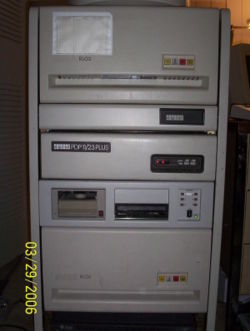Difference between revisions of "PDP-11/23-PLUS"
From Computer History Wiki
(Add cats, links) |
m (Avoid redir) |
||
| Line 11: | Line 11: | ||
|}} | |}} | ||
| − | The PDP-11/23 PLUS, introduced in November 1981, introduced an integrated solution on a single [[DEC card form factor |quad]]-width [[QBUS]] board, which included [[F-11 chip set|F-11]] [[Central Processing Unit|CPU]], [[memory management]] unit, a socket for inserting an [[KEF11-A floating point chip|KEF11-A]] [[floating point unit]], and two [[asynchronous serial line]]s, which had a maximum speed of 19,200 baud. | + | The PDP-11/23 PLUS, introduced in November 1981, introduced an integrated solution on a single [[DEC card form factor |quad]]-width [[QBUS]] board, which included [[F-11 chip set|F-11]] [[Central Processing Unit|CPU]], [[memory management]] unit, a socket for inserting an [[KEF11-A floating point chip|KEF11-A]] [[floating point processor|floating point unit]], and two [[asynchronous serial line]]s, which had a maximum speed of 19,200 baud. |
=== Essential parts that make up a PDP 11/23 PLUS === | === Essential parts that make up a PDP 11/23 PLUS === | ||
Revision as of 21:30, 9 September 2018
| PDP-11/23 PLUS | |
 PDP-11/23 PLUS with two RL02s, TK50, and third party SCSI. | |
| Manufacturer: | Digital Equipment Corporation |
|---|---|
| Year Introduced: | November 1981 |
| Word Size: | 16 bit |
| Physical Address Size: | 22 bit |
| Virtual Address Size: | 16 bit |
| Bus Architecture: | QBUS |
The PDP-11/23 PLUS, introduced in November 1981, introduced an integrated solution on a single quad-width QBUS board, which included F-11 CPU, memory management unit, a socket for inserting an KEF11-A floating point unit, and two asynchronous serial lines, which had a maximum speed of 19,200 baud.
Essential parts that make up a PDP 11/23 PLUS
- M8189 KDF11-B CPU board
- 22-bit QBUS backplane